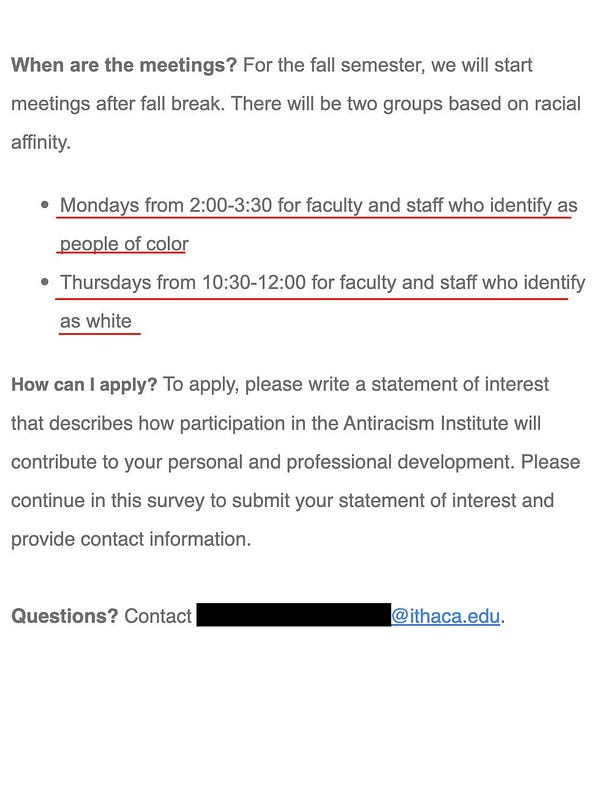E-Pluribus | October 6, 2022
Wokeness through the years, another blow to women's sports, and a prestigious art museum bows to the mob.
A round-up of the latest and best writing and musings on the rise of illiberalism in the public discourse:
Robert VerBruggen: Generations of Wokeness
Even as American society grows more racially diverse and more and more people eschew and deplore the inexcusably vicious and vacuous racism of previous generations, disagreement and debate over racial issues continue. At City Journal, Robert VerBruggen reviews Rosalie Pedalino Porter’s book America Challenged: The New Politics of Race, Education, and Culture and finds that even in matters of race, there is nothing new under the sun.
When Porter writes about bilingual education and the harms of “multiculturalism,” the reader might feel sucked into a time warp. Just as often, though, her recounting of past controversies synchronizes well with her coverage of the current era.
Anxiety about racial gaps—understandable given America’s history, but often corrosive in practice—has persisted over time. Discussing the thought of Manhattan Institute fellow Glenn Loury from the 1980s through the present, Porter notes a constant tension in the public debate between blaming whites for the poor performance of minority groups and stressing the practical need for self-help on the part of those who fall behind.
In roundabout and uncomfortable ways, the United States keeps coming back to the questions of why some groups are better off than others—and whose responsibility it is to change that. Over time, some terminology has evolved: for example, from “equality of opportunity” versus “equality of outcomes” to “equality” versus “equity.” And the modern vogue of equity-focused “wokeness” has reached heights of ridiculousness that 1990s-era “political correctness” could only dream of. Porter recounts some of the most notorious examples, often drawing on the reporting of City Journal’s Christopher F. Rufo, of major corporations and other institutions subjecting their employees and/or students to accusatory lectures about white privilege and “anti-racism.”
Read it all.
Jonathan Kay: Disc Golf’s Lia Thomas Moment
Biological males competing in women’s sports is one of those issues that perfectly fits the “imagine predicting this 25 years ago” thought experiment. At Quillette, Jonathan Kay introduces us to a professional sport that many might not even be aware of (disc golf, or frisbee golf) and to that sport’s reckoning with the transgender issue which is already making waves in its infancy.
For female professional disc golfers, the July 29–31 Discraft Great Lakes Open (DGLO) in Milford, Michigan represented a watershed—marking the first time in the young sport’s history that an Elite-series tournament offered women the same first-place prize money as men. “It should have been a great moment,” one of the female competitors told me once the crowds had gone home. “But then the thing ended, and the winners weren’t a male and a female. It was basically two males.”
By this, the woman was referring to male star Calvin Heimburg, who won what is formally called the “Open” division (but which, in practice, is 100 percent male); and the female-division winner, Natalie Ryan, a trans woman who’s been playing disc-golf tournaments for only three years. Despite this lack of experience, Ryan already is starting to make victory something of a habit, winning not only DGLO, but also a second Elite event in Leicester, Massachusetts this past weekend. As a result, Ryan is now ranked as one of the world’s top five female-classified disc golfers.
[ . . . ]
[I]ndustry publications such as Release Point have covered the issue of gender largely through Pride-themed homages to trans disc golfers. In early 2021, a PDGA Event Support and Training Manager named Mike Sullivan authored a long Twitter thread in which he assured everyone that “women’s divisions are not in danger of being dominated by whatever South Park satire version of transgender women you might be concerned about,” and warned that those voicing concerns had been swayed by “people with bad intentions” such as podcaster Joe Rogan.
Yet the PDGA’s own reported data suggest that performance differences between males and females are stark. In the “Advanced” amateur division (a classification that is technically open to all amateur players but which is almost entirely male), players typically are capable of throwing a maximum distance of between 300 feet and 450 feet. In the case of “Advanced Women,” on the other hand, the corresponding figures are a third lower: 200 feet and 300 feet. The world record for longest disc golf throw by a man is 1,109 feet. For female players, the record is 569 feet. And it is worth noting that Ryan, the female tour’s only trans player, also happened to win disc golf’s 2021 US Distance Championship in the female category with a throw of 458 feet.
Read the whole thing.
Helen Lewis: The Guggenheim’s Scapegoat
Helen Lewis’s latest for The Atlantic contains enough examples of posturing, obsequiousness, vitriol, hypocrisy and cowardice to put most soap operas to shame. The Guggenheim Museum’s sacrifice of one of its more impressive and loyal curators at the behest of a petty, sanctimonious and vulgar coworker on the altar of political expediency will be an indelible stain on that institution’s reputation for years to come.
In 2016, LaBouvier, then in her early 30s, arranged for the Williams College Museum of Art, in Massachusetts, to display Defacement as a powerful statement about police brutality by an artist whose commercial and critical reputation has continued to rise since his death. Nancy Spector, who would soon become artistic director and chief curator at the Solomon R. Guggenheim Museum, in New York, learned about LaBouvier’s work on the painting. She asked LaBouvier if she would like to collaborate on an exhibition where Defacement could be shown alongside other art responding to the death of Michael Stewart. The exhibition would speak to the political moment: In the years since 17-year-old Trayvon Martin had been shot dead, the Black Lives Matter movement had been steadily gaining strength.
Spector’s offer led to a high-profile exhibition at one of New York’s most prominent art institutions, making LaBouvier a trailblazing Black curator in a white-dominated world. It also began a chain of events that, in the summer after George Floyd’s murder, saw Spector cast out of the Guggenheim, branded a racist and a bully, and left unemployed—a phenomenon the Colombian artist Doris Salcedo described to me as a “social death.” All of this happened even though an independent investigation found “no evidence” that Spector had racially discriminated against LaBouvier.
How did a simple offer, over a single painting, lead to such a spectacular destruction of someone’s life and career? The answer involves the shifting sands of American corporate life, as newly activist staff demand that institutions take political positions. But there is also a much older ritual at work: the tendency of the powerful, when faced with rebellion and called to account for their own behavior, to dump all their errors on a single individual, whose removal then wipes the record clean.
Nancy Spector, in other words, was a scapegoat.
Read it all here.
Around Twitter
With quite possibly the first use of “juicy” and “janky” in the same tweet, Kyle Vitale introduces his Inside Higher Education essay about campus cancel culture:




One measure of one’s own wokeness is now apparently one’s willingness to throw oneself under the racism bus. Wesley Yang and Jesse Singal weigh in:




And finally, yes, the English language has now been compelled to string together the phrase “racially-segregated ‘antiracism’ program” against its better judgment:









